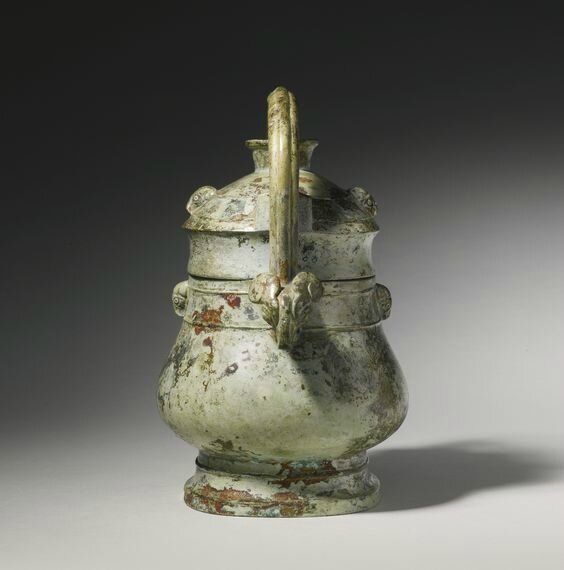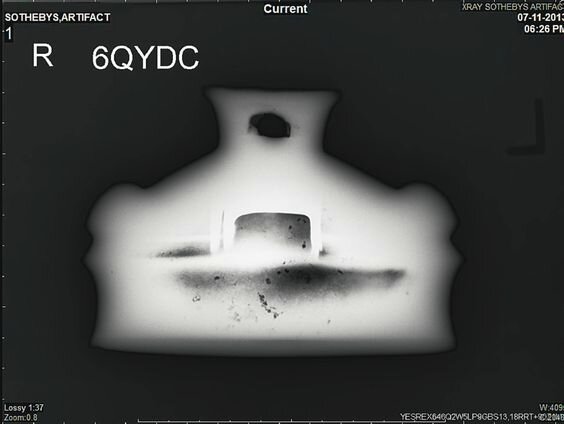The Zuo Ce Huan You, An important bronze wine vessel, Early Western Zhou dynasty, 10th century BC
Lot 8. The Zuo Ce Huan You. An important bronze wine vessel, Early Western Zhou dynasty, 10th century BC. Height 9 5/8 in., 24.5 cm. Estimate 200,000 — 300,000 USD. Lot sold 3,077,000 USD. Courtesy Sotheby's.
well cast of oval section, the slightly compressed pear-shaped body raised on a splayed pedestal foot encircled by a bowstring band, cast in high relief on each side of the neck with a tapir head between two bowstring bands interrupted by loops attached to the tapir-head terminals of the overhead arch handle, the slightly waisted domed cover with wedge-shaped tabs projecting from either end and decorated with a similar band, echoing the designs on the body, surmounted by a ring-shaped knob, with matching thirty-five-character inscription on the insides of both vessel and cover, the surface of mottled green patina and green and azurite encrustation on the interior.
Provenance: Collection of Wu Shifen (1796-1856).
Collection of Pan Zuyin (1830-1890).
T.Y. King, Shanghai, 1948.
Collection of H.E. Alexandre J. Argyropoulos.
J.J. Lally & Co., New York.
Exhibited: Mostra d'Arte Cinese, Palazzo Ducale, Venice, 1954, cat. no. 54.
Sun Yirang, Guzhou shiyi (Notes on ancient scripts), 1888, vol. 2, no. 2.
Liu Xinyuan, Guwen shen (An examination of ancient writings), 1891, vol. 4, p. 8.
Wu Shifen, Meigu lu jinwen (The record of pursuing antiquity: Inscriptions from archaic bronzes), 1895, vol. 2, p. 86.
Wu Dacheng, Kezhai jigulu (The record of collecting antiques in the Kezhai studio), 1896, vol. 19, p. 22.
Fang Junyi, Zhuiyizhai yiqikuanzhi kaoshi (Interpretations of inscriptions from archaic bronzes in the Zhuiyizhai studio), 1899, vol. 12, p. 9.
Zou An, Zhoujinwen cun, (Surviving writings from the Zhou dynasty), 1916, vol. 5, p. 89.
Ke Changji, Weihuage jigulu bawei, (Explanatory notes of inscriptions from archaic bronzes in the Weihuagestudio), 1916, vol. gengshang, p. 5.
Wu Kaisheng, Jijin wenlu (The record of inscriptions from auspicious bronzes), 1933, vol. 4, p. 9.
Yu Xingwu, Shuangjianchi jijin wenxuan (Selected inscriptions from auspicious bronzes in the Shuangjianchistudio) 1933, vol. 2.3, p. 10.
Gu Tinglong, 'Pangulou cangqi mu' (The list of bronze vessels in the Pangulou studio), Guoli Beiping Tushuguan guankan (Journal of National Beiping Library), vol. 7, no. 2, 1933, p. 80.
Guo Moruo, Liangzhou jinwenci daxi tulu kaoshi (A study of inscriptions from archaic bronzes in the Western and Eastern Zhou dynasties), 1935, vol. 1, p. 5, vol. 2, p. 14.
Liu Tizhi, Xiaojiaojingge jinwen taben (Rubbings of inscriptions from archaic bronzes in the Xiaojiaojinggestudio), 1935, vol. 4, p. 61.
Luo Zhenyu, Sandai jijin wencun (Surviving writings from the Xia, Shang and Zhou dynasties), 1937, vol. 13, p. 40.
Rong Geng, Shangzhou yiqi tongkao, (A general study of archaic bronzes in the Yin and Zhou dynasties), 1941, p. 44.
Jean-Pierre Dubosc, Mostra d'Arte Cinese, Venice, 1954, p. 32, no. 54.
Chen Mengjia, Xizhou qingtongqi duandai (A periodization of the Western Zhou bronzes), 1955-56, p. 116, pl. 9, fig. 17
Yang Shuda, Jiweiju jinwenshuo (A study of inscriptions from archaic bronzes in the Jiweiju studio), 1959, p. 185
Shizuka Shirakawa, Kimbun no sekai (A general study of inscriptions from archaic bronzes), pp. 236ff., no. 22.
Tang Lan, Xizhou qingtongqi mingwen fendai shizheng (A historical study of the Western Zhou bronze inscriptions), 1986, p. 293.
Jessica Rawson, Western Zhou ritual bronzes from the Arthur M. Sackler collections, Washington D.C., 1990, vol. 2b, p. 517, fig. 72.3.
Wang Shimin, Chen Gongrou, Zhang Changshou, Xizhou qingtongqi fenqiduandai yanjiu (A Study of the Periodization and Dating of Western Zhou Bronzes), Beijing, 1999, p. 126
The inscription clearly records a historical event and offers important clues for the study of the early dynastic history of China. Previously, several scholars including Guo Moruo (fig. 5) and Liu Qiyi thought that the bronze vessel belonged to the reigns of King Cheng (r. 1042-1021 BC) or King Kang (r. 1020-996 BC), but the majority of scholars now agree that it should be dated to King Zhao’s reign (r. 996-977 BC.). Although there are several alternative interpretations, regarding the making of the bronzes, the following is the most current. The inscription describes an exchange of gifts between the Zhou royal court and one of the regional powers; in the nineteenth year of the reign (978 BC), the royal consort Wang Jiang charged Huan, the Court Register to have a peaceful meeting with the head of the Yi-chiefdom Yi Bo (one theory is that he was the father of Wang Jiang). The latter then paid tribute to the Zhou court, and (Huan) made this ritual vessel as a sacrifice to his father. The event was also recorded on another bronze wine vessel the Zuo Ce Huan Zun (fig. 1), which was commissioned by the same person as a set together with the present piece, and is now in the collection of the National Palace Museum, Taipei and is included in Gugong xizhou jinwenlu (Inscriptions from the Western Zhou bronzes in the Palace Museum), Taipei, 2001, pp.60, no.33.
A tracing of this vessel’s inscription was first published in Wu Rongguang’s (1773-1843) Yunqingguan jinwen (Inscriptions from archaic bronzes in the Yunqingguan studio) (fig. 3) in 1842, with an explanatory note by the famous radical politician Gong Zizhen (1791-1841). In 1888, the illustrious scholar Sun Yirang (1848-1908) wrote an essay on the inscription, disputing Gong’s opinion; three years later another scholar Liu Xinyuan also commented on the naming of the vessel. Their studies all appear to be based on the rubbings published by Wu Rongguan. The whereabouts of the bronze itself, however, did not become public knowledge until its owner Wu Shifen (1796-1856) included the inscription in his books Meigu lu (The record of pursuing antiquity) (fig. 4), and Meigulu jinwen (Inscriptions from archaic bronzes in the record of pursuing antiquity), and in the former stated that the bronze you vessel was from his own collection. Although Wu compiled these books in the 1850s, they were not published until long after his death.
The latter half of the 19th century was a ‘golden time’ for private collectors in China, not because there were many of them, but more because they interacted closely with each other, sharing knowledge and trading pieces. After Wu’s death, and likely soon after, the bronze you entered the collection of another prominent collector, Pan Zuyin (1830-1890). In 1896, in his book Kezhai jigu lu (The record of collecting antiques in Kezhai studio), Wu Dacheng (1835-1902) included an ink rubbing of the Zuo Ce Huan You inscription with a stamped seal 'Zhen An cang you' (you from the collection of Zheng An). As mentioned earlier, Zheng An was another name of Pan Zuyin. Wu Dacheng (1835-1902) was a very close friend of Pan, also from Suzhou, and a celebrated collector himself. The provenance of the Zuo Ce Huan You can be confirmed by another original inscription rubbing in the collection of the Institute of History and Philology, Academia Sinica in Taipei, which bears another studio seal of Pan Zuyin, ‘Zheng An suo cang jijin’ (auspicious bronzes from the collection of Zheng An) on the lower left-hand corner (fig. 2). Further, the name of the bronze also appears in the list of Pan’s bronzes, which was compiled by Gu Tinglong, the nephew of Wu Dacheng, and the former director of the Shanghai Library which was published in Gu Tinglong, 'Pangulou cangqi mu' (The list of bronze vessels in the Pangulou studio), Guoli Beiping Tushuguan guankan (Journal of National Beiping Library), vol. 7, no. 2, 1933, p. 80.
Even though the inscription has long been familiar to scholars of Chinese bronzes and been published in more than twenty publications, the image of the vessel has rarely been seen. In his lifetime, Pan Zuyin kept his precious collection of bronzes in Pangulou and published only part of his bronzes in Pangulou yiqi kuanzhii (Inscriptions from archaic bronzes in the Pangulou studio). The majority of his bronze collection was never published, including the present youand the Mu Xin Zun, perhaps to ward off attention from powerful officials in the court, or thieves and forgerers.
Wu Shifen (1796-1856) was an epigraphist, calligrapher and Secretary of the Cabinet at the court of the Daoguang Emperor and was one of the great collectors of his generation. As a descendant of a renowned Shandong family, Wu was related through marriage to another prominent Shandong collector, Chen Jieqi (1813-1884). They collaborated on the ground-breaking book Fengni kaolue (Researches on clay bullae), in which ancient Chinese clay bullae were recorded and studied for the first time.
Sotheby's. Magnificent Ritual Bronzes. New York, 17 September 2013

/https%3A%2F%2Fprofilepics.canalblog.com%2Fprofilepics%2F1%2F0%2F100183.jpg)
/https%3A%2F%2Fstorage.canalblog.com%2F03%2F02%2F119589%2F96711876_o.jpg)
/https%3A%2F%2Fstorage.canalblog.com%2F11%2F31%2F119589%2F94773502_o.jpg)
/https%3A%2F%2Fstorage.canalblog.com%2F20%2F83%2F119589%2F94772815_o.jpg)
/https%3A%2F%2Fstorage.canalblog.com%2F26%2F72%2F119589%2F75604929_o.jpg)
/https%3A%2F%2Fstorage.canalblog.com%2F59%2F60%2F119589%2F26458628_o.jpg)














/image%2F1371349%2F20240406%2Fob_b23648_434058570-1644317966338216-88086167391.jpg)
/image%2F1371349%2F20240403%2Fob_6d5ae7_dp-28103-001.jpg)
/image%2F1371349%2F20240229%2Fob_8f31f9_431013694-1625286614908018-33034430839.jpg)
/http%3A%2F%2Fstorage.canalblog.com%2F79%2F20%2F119589%2F129837997_o.jpg)